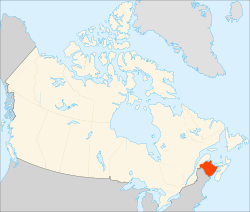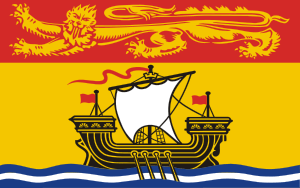Outline of New Brunswick

The following outline is provided as an overview of and topical guide to New Brunswick:
New Brunswick is a Canadian maritime province. The province, with an area of 72,908 square kilometres (28,100 sq mi), has a humid continental climate. It is the only constitutionally bilingual (English–French) province. Its urban areas have modern, service-based economies dominated by the health care, educational, retail, finance, and insurance sectors, while the rural primary economy is best known for forestry, mining, mixed farming, and fishing. New Brunswick's capital is Fredericton, and its largest city is Saint John.
General reference
- Common English name(s): New Brunswick
- Official English name(s): New Brunswick
- Adjectival/Demonym(s): New Brunswick/New Brunswicker(s)
- French: Nouveau-Brunswick; pronounced [nu.vo.bʁœn.swik], Quebec French pronunciation: [nu.vo.bʁɔn.zwɪk] (

Geography

- New Brunswick is: a province of Canada.
- Population of New Brunswick: 751,171 (2011 census)[1]
- Area of New Brunswick: 72,908 square kilometres (28,100 sq mi)
Location
- New Brunswick is situated within the following regions:
- Time zones (see also Time in Canada):
- Atlantic Standard Time (UTC-04), Atlantic Daylight Time (UTC-03)
- Extreme points of New Brunswick
Environment
- Climate of New Brunswick
- Ecology of New Brunswick
- Geology of New Brunswick
- List of protected areas of New Brunswick
- Wildlife of New Brunswick
Natural geographic features
Heritage sites
Regions
Regions of New Brunswick
Native reserves
Municipalities
New Brunswick municipalities
Demography
Government and politics
- Capital of New Brunswick: Fredericton
- List of post-confederation New Brunswick general elections (last 5)
- Political parties in New Brunswick
Branches of the government
Executive branch of the government
- Head of state: Queen of Canada, Queen Elizabeth II
- Head of state's representative (Viceroy): Lieutenant Governor of New Brunswick, Jocelyne Roy-Vienneau
- Previous lieutenant governors
- Head of government: Premier of New Brunswick, Brian Gallant
- Previous premiers
- Cabinet: Executive Council of New Brunswick
- Minister of Public Safety and Solicitor General
- Minister of Finance
- Minister of Natural Resources
- Minister of Human Resources
- Minister of Health
- Attorney-General of New Brunswick
- Minister of Education and Early Childhood Development
- Minister of Transportation and Infrastructure
- Minister of Agriculture, Aquaculture and Fisheries
- Minister of Economic Development
- Minister of Post-Secondary Education, Training and Labour
- Minister of Energy and Mines
- Minister responsible for Efficiency New Brunswick
- Minister of Government Services
- Minister responsible for Aboriginal Affairs
- Minister of Social Development (Canada)
- Minister of Healthy and Inclusive Communities
- Minister of Environment and Local Government
- Minister of Tourism, Heritage and Culture
- Head of state's representative (Viceroy): Lieutenant Governor of New Brunswick, Jocelyne Roy-Vienneau
Legislative branch of the government
- Parliament of New Brunswick (unicameral): Legislative Assembly of New Brunswick
- Federal representation
Judicial branch of the government
Law and order
Law of New Brunswick
- New Brunswick Bar Association: the provincial law society
- Capital punishment: none.
- Canada eliminated the death penalty for murder on July 14, 1976.
Military
Canadian Forces Being a part of Canada, New Brunswick does not have its own military.
Local government
History
History, by period
History, by region
Culture
- Provincial decorations and medals
- Festivals in New Brunswick
- Cinema of New Brunswick
- Media of New Brunswick
- Museums in New Brunswick
- Music of New Brunswick
- Public holidays in New Brunswick
People
- List of people from New Brunswick
- Acadians
- William Bennett (clergyman)
- Ethnic groups in New Brunswick
Religion
- Religion in New Brunswick
- Christianity in New Brunswick
- Islam in New Brunswick
- Hinduism in New Brunswick
- Judaism in New Brunswick
- Irreligion in New Brunswick
Sports
- Sport in New Brunswick
- UNB Varsity Reds
- Moncton Aigles Bleus
- Moncton Mets (baseball)
- Moncton Miracles (basketball)
- Saint John Riptide (basketball)
Symbols
- Coat of arms of New Brunswick
- Flag of New Brunswick
- Provincial flower: purple violet
- Provincial bird: Black-capped chickadee
- Provincial tree: balsam fir
- Provincial motto: Spem reduxit (Hope was restored)
- Provincial capital: Fredericton
Economy and infrastructure
- Media in New Brunswick
- Media of New Brunswick (category)
- List of television stations in New Brunswick
- List of radio stations in New Brunswick
- Currency: Canadian dollar
- NB Power
- Horizon Health Network
- Vitalité Health Network
- Transportation in New Brunswick
- Airports in New Brunswick
- Railway stations in New Brunswick
- List of New Brunswick provincial highways
Education
See also
References
- ↑ "Population and dwelling counts, for Canada, provinces and territories, 2011 and 2006 censuses". Statcan.gc.ca. February 8, 2012. Retrieved February 8, 2012.
External links
| Wikivoyage has a travel guide for New Brunswick. |
- New Brunswick at Curlie (based on DMOZ)
- Official site of the Government of New Brunswick
- Official site of Tourism New Brunswick
- New Brunswick at the Department of Canadian Heritage
- Maritime Tourism
- Symbols of New Brunswick
- New Brunswick Museum
- New Brunswick Lighthouses
- Historical and Genealogical Resources of New Brunswick historical census, birth, marriage and death records, immigration, settlement, biography, cemeteries, burial records, land records, First Nations and more
- From Louis to Lord: New Brunswick Elections, 1960–2003
